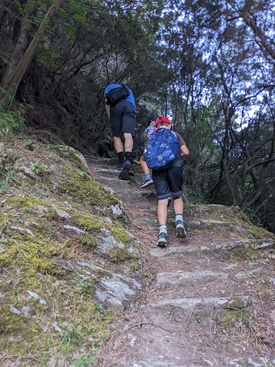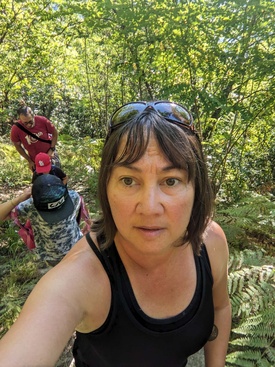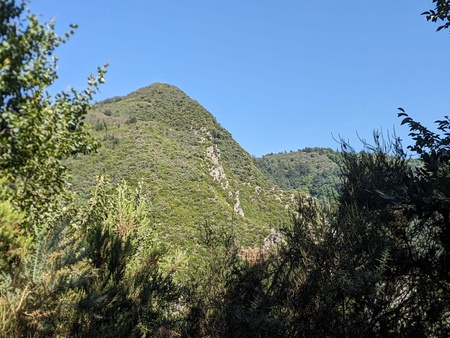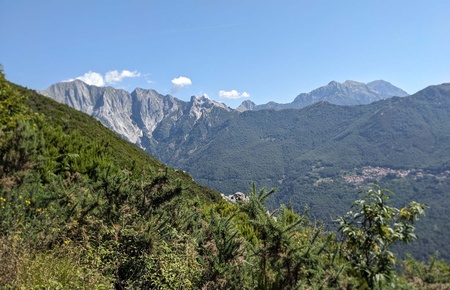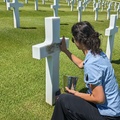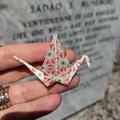Dear Grandpa,
I read that Japanese Americans in the 100th/442nd were credited with breaking through the Gothic Line in Italy. And that the Gothic Line was a defensive boundary built across the Italian Apennine mountain range by the German Army during WWII to maintain control of the area. It was the last great defensive position that the Germans controlled in Italy, and previous American troops had been unsuccessful at breaching it due to the rugged terrain. The troops had suffered tremendous losses.
The US Army brought in the Nisei soldiers and their capture of the Gothic Line in April 1945 signaled the beginning of the end for the German Army’s occupation in Italy. The war ended shortly thereafter.
Nat and the kids and I hiked up Monte Folgorito in the Italian Apennine range, not too far from Pietrasanta, where we were staying. It is a beautiful, lush, pointed peak at nearly 3,000 feet elevation that rises up sharply from the Mediterranean Sea. It sits across the valley from the world renowned Carrara marble quarry, which from afar looks like a giant castle. Little villages are nestled at its base.
During the war, the Nisei soldiers ascended Monte Folgorito from several directions, in silence and under the cover of darkness, always under the threat of gunfire.
I wanted to do the hike, to see what it was like, get to the top, look at the view. We took the frontal assault path of the 100th Battalion. I knew it would be difficult. We promised the kids two scoops of gelato and unlimited screen time for the rest of the day if we made it to the top. It was a great incentive that kept them going without much complaining.
But the terrain was incredibly challenging, with steep switchbacks carved into the mountain. I’ve heard that the trail is in better shape now than it was back then, but it was still overgrown with tall, sharp foliage that swatted at our faces and legs as we walked.
Lizards scurried through the ground cover that sounded like a crunching of dead leaves, and I kept fearing the noises were snakes. Enormous spider webs blanketed the shrubs and bug carcasses were scattered throughout the lair. I tried not to look at the giant spiders, and at the same time wanted to know exactly where they were so I could avoid them.
At one point, Nat came to a stop and told us to be quiet. He had spotted something. A wild boar and two of her babies were up ahead on the trail. In Wyoming, we generally know what to do about wildlife encounters–moose, bear, mountain lions, rattlesnakes. But we don’t have wild boar where we live and we didn’t know what to do. Do we make noise? Do we stay silent? Are they aggressive? What do we do if they attack? Do we run towards them or away from them? We retreated, pulled out our phones, and started Googling.
Cinghiale, as the Italians call them, are native to Europe and live in the forests of Italy. They are hunted for their meat. While the babies could be considered cute, with brown and tan stripes covering their small bodies, like baby fawns, the adults are large and downright ugly. Their skin is covered in coarse fur, and they have a long snout and tusks.
Despite their stout body and relatively skinny legs, they can run fast, at almost 30 miles per hour. According to Google, mostly they’re shy animals, with poor eyesight but a keen sense of smell. But if threatened, they could attack. How would we know if a wild boar felt threatened?
I heard a loud grunt from above and looked up the side of the mountain to see a large black and greyish rump scuter through some shrubs. I wanted to turn around, go back to town, be done with the hike. I didn’t need to add a wild boar attack to our travel itinerary. But then we heard some clicking from behind. Something else was approaching us, on the trail.
Wild boar ahead on the trail, wild boar above us, and some loud clicking coming from behind. We were surrounded. I couldn’t tell if I was sweating from the heat or from my heart pounding from fear. The clicking got louder, and suddenly, from behind the shrubs, I saw her. A hiker emerged. The clicking noises were coming from her hiking poles against the rocks on the trail. I laughed out of relief.
“Bonjourno,” we greeted each other.
“Parla inglese?” I asked.
“No,” she said.
“Cinghiale,” I pointed ahead on the trail. I didn’t know how to pronounce it and I could tell she didn’t understand.
Nat showed her a picture on his phone, and she lifted up her glasses to see. Her eyes widened when she saw the photo.
“It’s dangerous? Um, peligroso?” I said it in Spanish, hoping she’d understand, and I could tell she did.
She raised her eyebrows and her shoulders and gently nodded, as if to say, “maybe.”
She showed me her sharp hiking poles and gestured, and I understood that she was telling us to wait, that she would go first. So we watched her click ahead slowly. About 50 steps from us, she pointed her poles and waved at us to continue. She was pointing at a stream of water coming from the rocks. That’s why the boars were there–they were thirsty.
We followed the woman for a while. I felt safer following a local with sharp poles. But after several switchbacks, we fell behind. We couldn’t keep up with her pace, so we didn’t try. We would be on our own again.
It took us three and a half hours to hike three miles. We gained 2,200 feet of elevation. When we got to the ridge where the Gothic Line was, the canopy of trees no longer protected us from the sun. My phone said it was 98 degrees. We continued along the dry dirt and rocky path, past caves and old stone bunkers.
We made some wrong turns, got off trail a few times, and had to retrace our steps back through the spiny shrubs. We have to be getting close, we thought. We had been hiking for so long. But suddenly, we came around a corner where there was a break in the trees. We looked to the right, and could see the summit from afar.
As the crow flies, we were probably less than a mile from the top of Monte Folgorito, where a large cross has since been erected. But it was going to take us at least another hour to get there on even steeper terrain, and it was hot and we were almost out of water. I was worried about coming back down, slipping and twisting an ankle. The kids had been so tough, but they were exhausted.
We decided to hike a short distance more to get to another ridge with a view of the valley and the ocean. We took in the beauty of the landscape and took some pictures, took some selfies. And then we carefully headed down.
I thought a lot about you as I hiked, Grandpa. You were in the Anti-Tank Company of the 442. I read that because of the terrain in this area, tanks weren’t used. So you provided support to the war efforts in other ways, like evacuating the wounded. This is what you meant when you said you had to collect your injured and dead comrades from the battlefields in Italy. Monte Folgorito was one of those battlefields.
I can’t imagine having to carry down injured soldiers from that mountain, or any other mountain in that area. I don’t want to imagine being injured there.
We didn’t make it to the summit of Monte Folgorito. We made the choice to go back down because it was just too hard and too hot, and we were too tired and too thirsty. You didn’t have the luxury to quit though, like we did. You didn’t have the luxury to turn around, to say, “this is too hard. It’s too hot; I’m too tired; I’m too thirsty. I’m afraid of spiders, of snakes, of wild boar. Of getting injured. Of getting killed.” Did you, Grandpa. And neither did your comrades.
Because you were Japanese American soldiers in the United States Army. You had more valiant reasons to hike than a couple of selfies and a nice view. You all had something to prove. And that was worth dying for.
I’m sorry I didn’t understand that when you were alive. I think I do now.
Thank you for your service.
Love,
Lena
© 2023 Lena Newlin


